Cat door training is the process of teaching your cat how to use a cat door, which is a small, usually flap-covered opening installed in a door or wall to allow your cat to come and go as they please.
Cat doors come in various shapes and sizes, can be made from plastic, wood, or metal, and usually have weather-resistant features to withstand the elements so that they last longer and don’t allow the wind and rain into your home.
There are many benefits to having a cat door in your home, including giving your cat the independence to come and go as she wishes and providing her access to the outside or specific areas of your home while you still maintain some degree of security and control.
In addition, a cat door removes the need for you to constantly open and close doors for your pet, making it a convenient solution for both your furry friend and you. Finally, a cat door can prevent unwanted animals, such as stray cats, foxes, possums, and even snakes, from getting into your home.
According to Forbes, over 46 million US homes own cats, making felines the second most popular family pet after dogs, and around half of those have a pet door!
According to Forbes, over 46 million US homes own cats, making felines the second most popular family pet after dogs, and around half of those have a pet door!
Read this guide to learn the many benefits of cat door training in more detail and find out how to choose a cat flap that perfectly suits your needs.
What Are The Benefits Of Cat Door/Cat Flap Training?
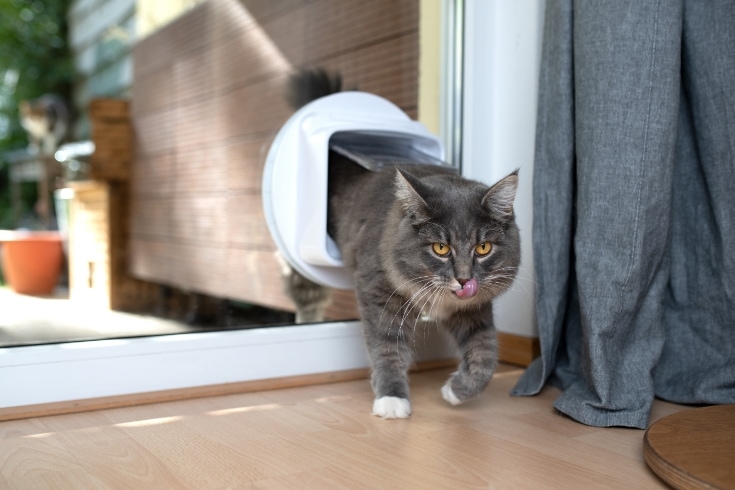
The benefits of cat door training are many and varied!
A cat door enables your cat to enter and leave your property as and when she chooses, saving you from getting up and letting her out and giving you peace of mind when you’re out. A cat door can prevent your cat from scratching at doors and windows when she wants to get outside, and you can also use a cat door to restrict your cat’s access to specific areas of your home if you want to, for example, a litter box room.
Here’s a detailed overview of all the benefits a cat door can offer you and your pet.
Increased Independence For Cats
Cats are naturally independent creatures that love to come and go as they please.
Both my cats spend part of the day or night outside and the rest of the time indoors, sleeping or eating, and having a cat door gives them the freedom to choose where they want to be. That helps to reduce the stress and anxiety that can be caused if a cat wants to get outside but can’t.
Reduces The Need For Human Assistance In Letting The Cat In Or Out
No one appreciates being woken in the middle of the night because the cat wants to go out! A cat door means that your cat can come and go without the need for human assistance, saving you from becoming a human bellhop in a cat hotel!
Provides Cats With Free Access To Outdoors Or Specific Rooms
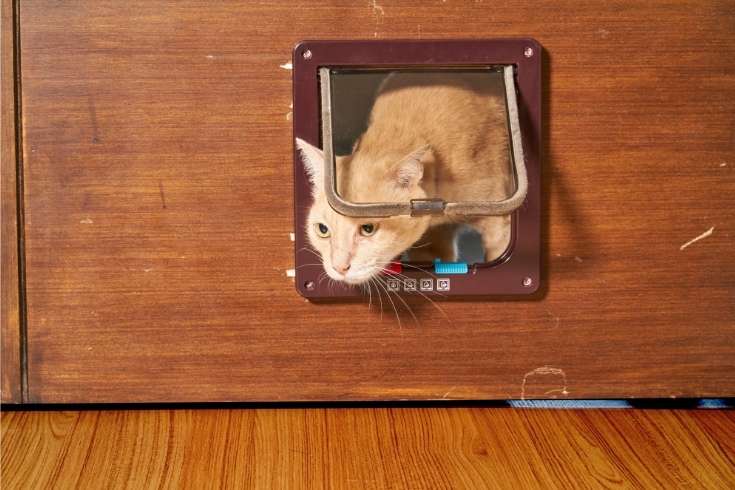
If your cat is permitted to go outside, it’s handy if she can go out whenever she wants to via a cat door. In addition, you might want to keep your cat out of certain rooms in your home at night, and a cat door can provide a perfect solution.
Can Help Manage Territorial Issues In Multi-Cat Households
If you have more than one cat, territorial issues within the household can arise, especially when bringing a new cat into an existing community. A cat door can help manage territorial issues in multi-cat households by preventing certain cats from accessing the territory that others have claimed.
Can Reduce Potential Behavioral Issues By Offering More Freedom
Behavioral issues, such as excessive vocalization and furniture scratching, can be reduced substantially by offering your cat more freedom to come and go as she wishes through a cat door.
Useful In Regulating Cat’s Access To Certain Areas (Like A Litter Box Room)
If your cat has a medical condition that leaves her incontinent or is struggling with litter box training, regulating your pet’s access to certain areas, such as a litter box room, can be useful, and a cat door enables you to do that.
Helps To Maintain Cleanliness By Restricting Access To Litter Box Area
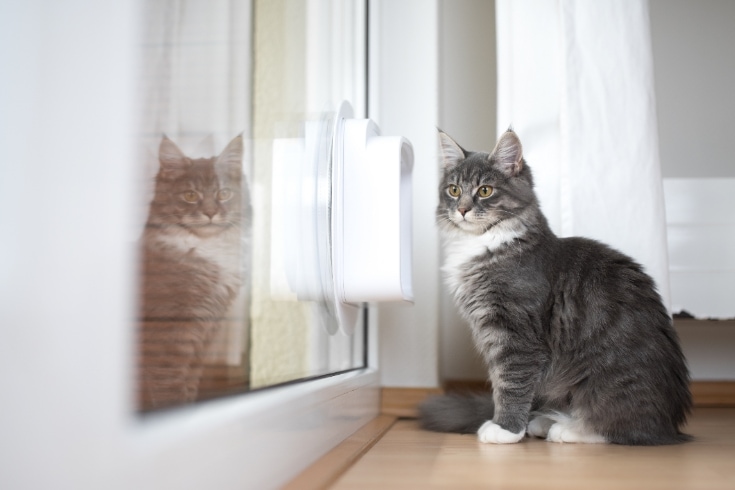
If you have a senior cat or one with medical conditions that cause her to eliminate outside of the litter box occasionally, it can be helpful to restrict your pet’s access to the litter box area when you’re not at home to supervise her and a pet door can enable you to do that.
Reduces The Risk Of Unwanted Animals Entering The House (In The Case Of Microchip Or Magnetic Doors)
As mentioned above, some cat doors feature a microchip that matches one implanted in your cat or a magnet set in her collar. The cat door will only open for your cat, effectively preventing unwanted animals, such as strays, feral cats, raccoons, and even snakes, from getting into your home through the cat door.
Gives Owners Peace Of Mind Knowing Their Cat Can Come And Go Safely
If you spend a lot of time away from your home on business or out at work, having a cat door that your cat is trained to use gives you peace of mind knowing she can come and go safely when she wants to.
Could Assist In Reducing Scratching At Doors Or Windows
Some cats exhibit bad behaviors if they can’t get out when they want to, such as scratching at doors or windows and causing damage to your home. A cat door can help to stop that because your cat can enter and leave your home at will.
Assists In Keeping Cats Active, Enhancing Their Physical Health
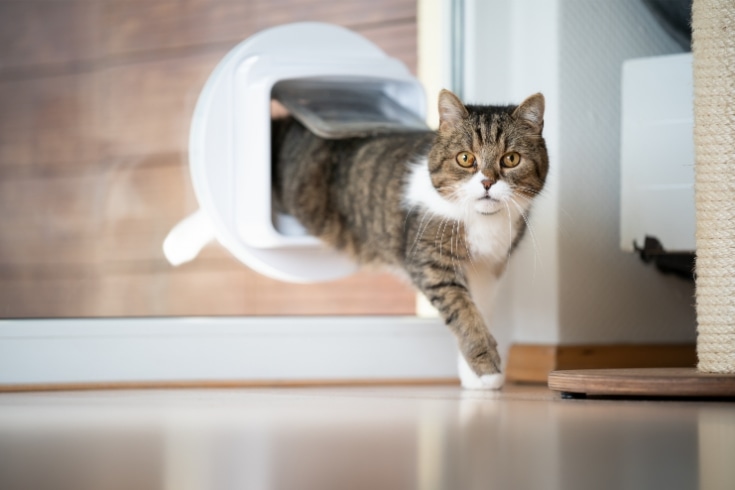
All cats, regardless of age, need a certain amount of daily exercise to keep them fit and active and maintain a healthy weight. Access to a cat door means your cat can get outside whenever she wants to, meaning she will get more exercise and likely enjoy better physical health than a couch potato kitty who spends all day snoozing on the windowsill in the sun!
How To Choose The Right Cat Door or Cat Flaps?
Choosing the right cat door or cat flap can be challenging and confusing for owners who haven’t had one before since there are many different styles to choose from at different price points. It’s vital to get the right cat door for your needs, so keep reading to learn how to choose the right cat door or cat flap for your pet and your home.
Different Types Of Cat Doors/Flaps
Different types of cat doors and cat flaps are designed to suit different home circumstances and fit various budgets, and there are lots to choose from!
Basic Manual Cat Door
The basic manual cat door consists of a hinged flap that swings inwards or outwards and is opened when your cat pushes against it. You can lock the door when not in use to prevent entry or exit.
Magnetic Cat Flap
As the name suggests, magnetic cat flaps use magnets to control access. Basically, the cat wears a collar with a magnetic key, and when the cat approaches the cat door, the magnet triggers the door to unlock, allowing the cat to pass through. This type of cat door is great for keeping out unwanted animals that do not have the magnetic key required to open the door.
Infrared/RFID Cat Door
Infrared or Radio Frequency Identification (RFID) cat flaps work in a similar way to magnetic flaps, but they use infrared or RFID signals instead of magnets. The cat wears a collar with an RFID tag, and the cat door’s sensor reads the tag to unlock the door for the cat.
Microchip Cat Flap
Microchip cat flaps are one of the most advanced options you can choose from and are designed to work with your cat’s implanted microchip. The flaps scanner reads the microchip’s unique ID, allowing only your cat to enter and keeping other animals out.
Electronic Cat Flap
Electronic cat flaps provide more control over entry and exit and often include programmable features, such as settings specific times for the door to unlock or lock automatically.
Dual-Scan Cat Door
Dual-scan cat doors have both an entry and an exit scanner, meaning the cat must be microchipped or wear an RFID color tag on entry and exit. This clever feature helps prevent other animals from following your cat back into your home through the cat door.
Manual Locking Cat Door
Some cat doors have a simple manual locking system that lets you lock the door from either side, which is useful if you want to keep your cat inside or outside during specific times.
Weatherproof Cat Door
Weatherproof cat doors are designed to provide better insulation and protection against inclement weather conditions, keeping your home more comfortable and energy-efficient.
Transparent Cat Flap
Some cats are uncomfortable using a cat door, and a transparent cat flap with a clear panel makes it easier for the cat to see through to the inside or outside, which can help encourage your feline friend to use the door.
Essential Factors To Consider In Choosing A Cat Doors/Flaps
The factors to consider when choosing a cat door or cat flap are the size of your cat and where you want to install the door. Ideally, you want a door that suits the aesthetic of your home, as well as operating smoothly, and being durable enough to cope with long-term daily use.
Consider whether you want a basic manual design or one that offers more techie features, such as a microchip or RFID option, and research how easy the door is to install.
Here’s a more detailed overview of what essentials you must consider when choosing a cat door for your home.
Evaluate The Size Of Your Cat
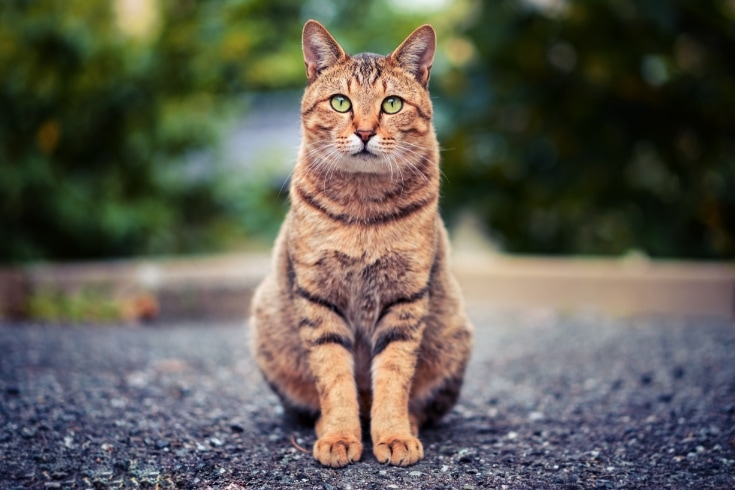
First of all, and most importantly, you need to know that your cats will easily fit through the cat door! I know that sounds kind of obvious, but many cat owners have purchased a cat flap only to discover that their large Maine Coon won’t squeeze through it.
Most cat doors are a standard, one-size-fits-all design, but double-check that your cat will fit through the door before you buy. If the door is too small, your cat will be reluctant to use it, which defeats the whole object of having a cat flap.
Consider The Location Where The Cat Door Will Be Installed
The location of the cat door should be somewhere that fits your cat’s daily habits and is easy to access for both your pet and yourself. If the cat door is designed to allow your cat to get outside, ensure it will not allow your cat to go straight out onto a road or into a potentially dangerous situation.
Look For Doors With Adjustable Settings For Controlling Access
Look for a cat’s door that offers adjustable settings for access control so you can decide when your cat can enter or exit, providing flexibility and home security.
Opt For A Door That Matches The Aesthetic Of Your Home
Choose a cat door that complements the design and style of your home, blending in seamlessly with your existing doors and walls rather than sticking out like a sore thumb.
Choose A Durable Material That Can Withstand Wear And Tear
Cat stores are not the cheapest purchase you will ever make, so pick a robust and long-lasting material to ensure that the cat door remains in working condition and doesn’t wear out easily, even with frequent use.
Consider An Energy-Efficient Cat Door If Installing In An External Wall Or Door
The last thing you want is a drafty cat door that allows a chilly winter wind to blow straight into your home, so if the cat door is to be installed in an external wall or door, choose an energy-efficient model that will help to keep your home included and minimize energy loss.
Consider Safety Features Such As Lock Settings
It is not unknown for burglars to use a cat flap to gain access to a property, so for your safety and security, always choose a cat flap that has reliable lock settings that will keep your cat securely inside your home when necessary while preventing unwanted access from outside.
Choose A Microchip Or Magnetic Door To Prevent Other Animals From Entering
If you’re concerned that wild animals or strays will get into your home via the cat door, I advise that you choose a microchip or magnetic door that restricts entry to your cat only.
Decide Between Manual And Automatic/Electronic Doors
For the ultimate convenience, you should choose an automatic or electric cat door that opens automatically without manual intervention. However, if you want a cheaper option and don’t mind getting up to open the door when your cat wants to come in or go out, go for a manual cat door.
Consider Doors With A Transparent Flap For Cats Who Prefer Visual Access
Some cats prefer to see what’s on the other side of the door before passing through, so a transparent flap is a good option for these careful kitties and can make training your cat to use the door much easier.
Evaluate The Ease Of Installation
Hiring a professional to install and set up your cat flap is well worth considering unless you’re big into DIY. Even so, when choosing the cat flap, I advise that you double-check the unit is relatively easy to install to reduce costs and hassle.
Make Sure The Door Has A Smooth Opening And Closing Mechanism
The cat door you choose should have a smooth opening and closing mechanism to prevent your cat from becoming stuck or reluctant to go in and out through the door.
Check Customer Reviews And Ratings
Before parting with your hard-earned cash, take the time to read ratings and reviews left by other cat owners to get an insight into the reliability and performance of different cat door models.
Look For A Door That Comes With A Warranty Or Guarantee
Even expensive cat doors can malfunction sometimes, so always choose a cat flap that comes with a warranty or guarantee to give you peace of mind and protection against the potential failure of the device in the future.
Step-By-Step Guide To Training Your Cat To Use A Cat Door
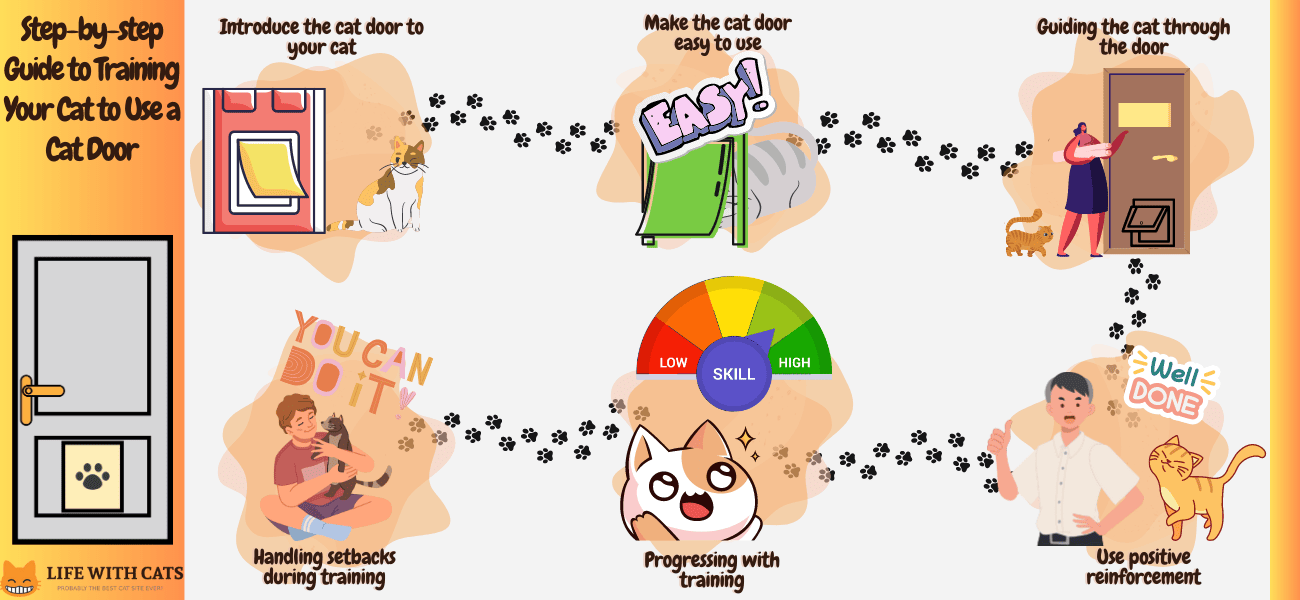
Of course, it’s all very well investing in an all-singing, all-dancing cat door packed with fancy features if you cannot persuade your pampered pussycat to use it!
In this part of our guide, we provide you with a simple, effective step-by-step guide to training your cat to use a cat door.
Introduce The Cat Door To Your Cat
Start by putting the cat door on the floor, and let your cat investigate and examine it at her own pace. Encourage your pet to approach the door by sitting beside it yourself and offering your cat treats or a toy, which helps create a positive association with the new door.
Make The Cat Door Easy To Use
Be sure to buy a cat door that’s the appropriate size for your cat so she can walk through easily without getting stuck or squeezing herself through.
If your cat has long claws, it can be helpful to trim them to prevent any snagging or discomfort that could happen while your pet uses the door.
Prop the cat door open slightly at first, so your cat can see through it and know that she has access to open space beyond the door.
Guiding The Cat Through The Door
With the cat door still propped open, gently guide your cat through the opening by offering her treats or toys and use a reassuring tone to encourage your pet. Repeat that process several times until your cat becomes comfortable with the idea of moving through the open door and does so without hesitation or reluctance.
Use Positive Reinforcement
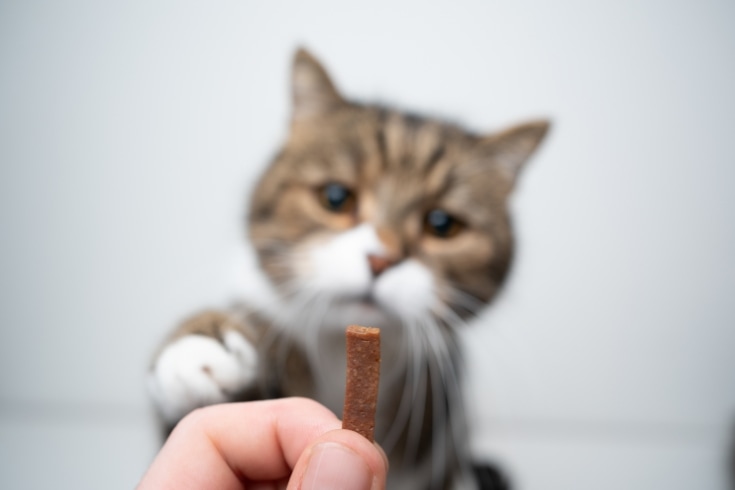
Each time your cat goes through the door voluntarily, use positive reinforcement in the form of verbal praise and treats to help create a positive association with using the door.
Never punish or frighten your cat if she is hesitant to use her new cat door because that will cause fear or anxiety around it, making your cat less likely to use the door.
Progressing With Training
When your cat is confident with the door propped open, you can install the door with the flap closed but not sealed shut so that your cat can push the door open with minimal resistance.
Encourage your cat to push her way through the door by holding treats or her favorite toy on the opposite side of the door. A trick that’s worked for me in the past is to sit by the door and gently nudge it open to show your cat what to do.
Keep practicing this daily for short sessions until your cat becomes comfortable using the door on her own.
Handling Setbacks During Training
Don’t worry if you experience a few setbacks during training, as that is to be expected, especially if you have taken on a cat from a shelter who has spent her previous life living on the streets.
As with all training and learning, some cats adapt more quickly to using the cat door than others, so you must be patient and don’t try to rush the process. If your cat is anxious, afraid, or refuses, point blank to use the cat door, take a step or two back in the training process, and start again using positive reinforcement.
Do not force your cat through the door or use negative reinforcement, as that can create fear which will undoubtedly set back the training process.
Keep training sessions short and positive to keep your cat interested and motivated, and always be consistent with your approach. If any of your family members are helping to train your cat to use the cat door, ensure they are using the same training methods as you.
Remember that every cat is unique, and the time it takes to train your pet to use her cat door might vary, so don’t despair or give up; you will get there eventually, and your cat will love the freedom her new door gives her!
What Are Common Issues In Cat Door Training?
Challenges in cat door training can include common problems, such as the cat refusing to use the door, not understanding how to use the door, only using the door to exit but not enter or vice versa, or scratching at the door rather than walking through it.
Don’t despair, we’ve prepared a detailed guide to the common issues experienced by many owners during cat door training, together with simple solutions.
Cat Shows Fear Or Anxiety Towards The Cat Door
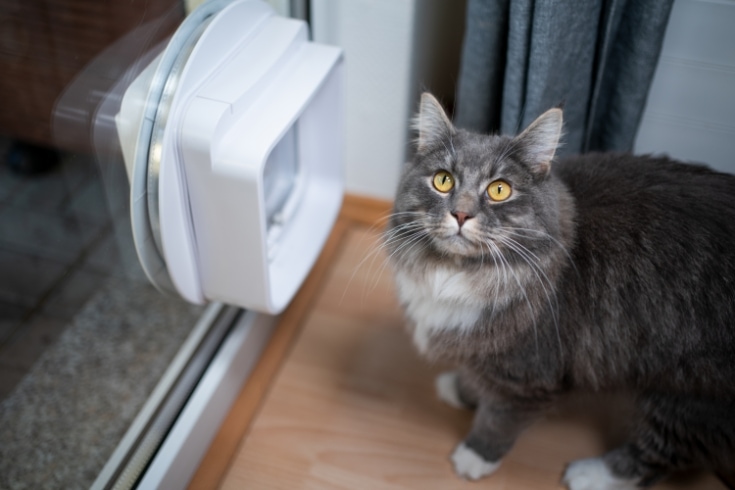
It’s not uncommon for some cats to be afraid or anxious about using a cat door, especially if it’s unfamiliar or they have had negative experiences with one in the past.
To ease your cat’s anxiety, you must take a gradual approach to desensitizing her to the door. Start by introducing your cat to the door and putting treats or toys near it to encourage her to explore and investigate the new device. Each time your cat approaches the door and sniffs it, reward her with a treat, praise, and reassurance that the door won’t hurt her and is perfectly safe to be around.
Patience and positive reinforcement will help to create a positive association for the cat with the door, helping to ease her fear and anxiety.
Cat Refuses To Use The Cat Door
Your cat could be hesitant to use the new cat’s door and might prefer the comforting reassurance of having you open the door for her.
Leave the door open, and try using a treat to entice the cat to the other side of the door, gently guiding her through it a few times to show her that it’s safe. Always be patient and do not force the cat through the door, as that will make her reluctance to use it even worse.
Cat Uses The Door To Exit But Not To Enter, Or Vice Versa
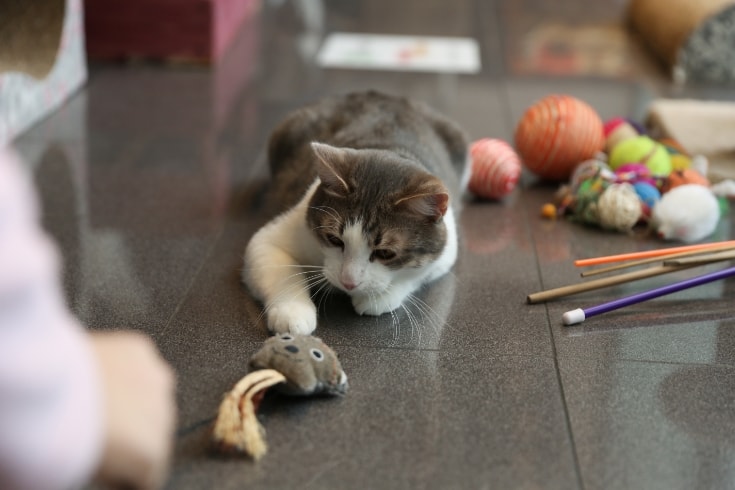
If your cat is happy to go out of the door but does not come in, try placing treats or your pet’s favorite toy inside the house to entice her to come back in. You can use a similar strategy to encourage a cat that only uses the door to enter the house by placing treats and toys outside.
Over time, your cat should begin using the door to enter and exit the house.
Cat Only Uses The Door When It’s Propped Open
Although it’s great news that your cat uses the door when it’s propped open, it’s not so good when she won’t go through when it’s fully closed. That’s not uncommon, as many cats don’t like the idea of having to push against an apparently solid object.
Try gradually closing the door a little more each day and keep encouraging your cat to use it by offering her treats, toys, and gentle guidance until she understands that the door can still be used even when it’s closed.
Avoid leaving the door propped open because that will only reinforce your cat’s insistence on using it in that state.
Multiple Cats In The Household Cause Territorial Issues Over The Door
In a multi-cat household, territorial disputes or conflicts can sometimes break out over the door, and that can prevent some cats from using it freely.
If territorial issues continue, the easiest solution is to install multiple cat doors in different locations to provide each cat with a separate exit and entry point. You should also investigate ways of preventing territorial behavior and competition, such as providing multiple resources like food and water stations and litter boxes in different parts of the house.
Cat Is Scared Or Startled By The Noise Of The Flap
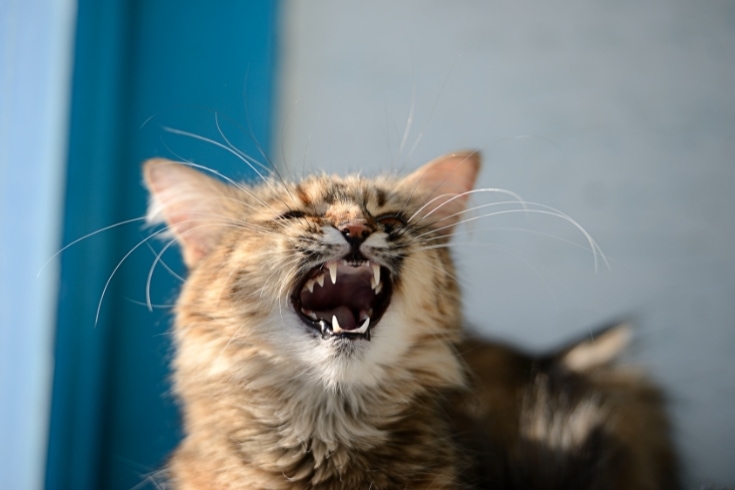
When pushed or swung closed, some cat doors have quite noisy flaps, which can startle and frighten sensitive or nervous cats.
If your cat is frightened by the noise of the cat door closing and opening, consider replacing the door with one that has a quieter mechanism or try adjusting the existing one to minimize the noise.
Alternatively, you can help desensitize your cat by gradually exposing her to the sound of the door and using positive reinforcement, such as treats or rewards, during the process so that your cat associates the noise with something pleasant instead of being afraid.
Cat Attempts To Use The Door But Struggles To Push The Flap
If the cat flap is heavy or stiff, which can be the case when it’s first installed, your cat might have difficulty pushing the flap and getting the door to open, especially if she is small and lightweight.
Start by lubricating the hinges or flap connections so that it’s easier for your cat to move. If that is ineffective, you might need to consider replacing the cat door with a lightweight flap that is easier for your cat to push open.
Cat Scratches Or Claws At The Door Instead Of Walking Through It
Instead of walking through the door, your cat might scratch or claw it, which is not only destructive but tells you your cat is unsure about using it.
In that case, you’ll need to correct your cat’s undesirable behavior by using positive reinforcement to encourage her to use the door properly, rewarding her when she walks through the door instead of scratching it.
It can also be helpful to place a scratching post near the door to redirect your cat’s behavior without denying her the opportunity to scratch if she wants to.
Cat Only Uses The Door When Prompted Or Enticed With Treats
If your cat only uses the door when prompted or tempted with treats, that’s likely because she’s not learned how to use the door independently.
Gradually reduce the frequency of offering your cat treats or prompting her to use the door, rewarding her only occasionally when she does the right thing. Be consistent to help your cat become more confident in using the door without any motivation from you.
It can be helpful to block any other exit points so that the cat is more likely to use the cat door when she wants to go out.
Other Animals Attempting To Use The Cat Door, Causing The Cat To Feel Threatened
Sometimes, you might find a stray cat or one of your neighbor’s cats trying to get in through the cat door. There have even been incidents of wildlife, such as foxes, raccoons, and snakes sneaking in undetected to wreak havoc while you’re out at work! That kind of behavior leaves your cat feeling afraid and threatened and leaves the alarming scent of an illegal alien at the entrance to her home, making her reluctant to use the door.
If you live in an area where unwanted intruders are a problem, consider getting a cat door with selective entry mechanisms, such as a microchip or collar sensor that only your cat can use to stop interlopers in their tracks effectively.
The Cat Door’s Positioning Or Height Is Not Comfortable For The Cat
If your cat door is too high or too low, it might be difficult or uncomfortable for a kitten or senior cat to use, so she ignores it.
In that case, you might have to go back to the drawing board and refit the cat door at a height that allows your cat to walk through comfortably. Measure your cat’s height from the floor to the top of her back to calculate the perfect door height, and make any necessary adjustments to ensure ease of use for your pet.
Cat Door Is Not Durable Or Stable Enough, Causing It To Malfunction
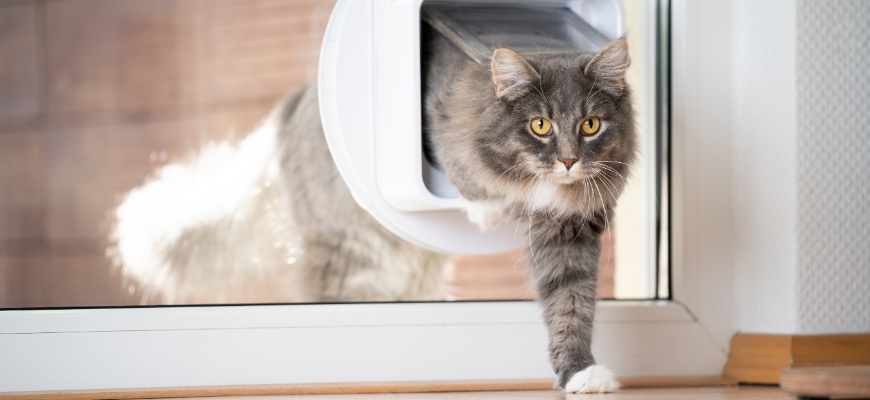
If you try to save money and buy a cheap cat door, you could have issues with it malfunctioning, making your cat anxious or even frightened of using it.
Prevention is better than cure in this case, so be sure to buy the best cat door you can afford that’s high-quality, sturdy, and will withstand regular use. Remember to test the door before you install it to be sure it works smoothly, and don’t be afraid to return the device to the retailer if you’re not satisfied.
The Cat Reverts To Previous Behavior After Initial Success
Even after successfully using the cat door to start with, some cats might revert to their previous habits and avoid using it if they can.
Regression of that nature is a common problem that needs patience and perseverance to cure. You’ll need to persevere with positive reinforcement training methods, rewarding and encouraging your cat to use the door regularly so that, given time and consistent positive experiences, your cat will soon start using the door again.
Cat Door/Cat Flap Training FAQs
Now that you have your cat door fitted and have started training your furry friend to use it, you’ll probably have a few questions.
In this section of our guide, we answer some of the most commonly asked questions about cat door training to help you.
How Long Does It Typically Take To Train A Cat To Use A Cat Door?
The length of time it takes to train a cat to use a cat door varies between individual cats. Some felines pick up the idea of entering and exiting your home through the door in a matter of days, whereas others can take weeks or even months.
What Can I Do If My Cat Is Scared Of The Cat Door?
If your cat is scared of the cat door, try using positive reinforcement techniques consistently to encourage her by rewarding her with treats and praise when she approaches the door. That way, your furry friend will learn to associate the cat door with a pleasant experience and will gradually overcome her fear.
What Type Of Cat Door Is Best For Training Purposes?
The best type of cat door for training purposes is a transparent door with a quiet mechanism. That style of a door allows your cat to see what’s on the other side, giving her confidence that nothing scary is waiting for her, and a quiet operating mechanism prevents your feline friend from being startled when the door operates.
How Can I Encourage My Cat To Use The Cat Door For The First Time?
Rather than expecting your cat to push the cat door open, try propping it open so that your pet can see what is on the other side and step through easily. Encourage your cat to use the cat door by placing some treats or a favorite toy on the other side of the door and gently guiding your cat through it, using a tasty treat to tempt her.
How Can I Use Treats Or Toys To Train My Cat To Use The Cat Door?
You can use treats or toys to train your cat to use the cat door by propping the door open and placing a few of your cat’s favorite treats or toys on the opposite side of the opening. Encourage and guide your cat through the opening to get the treats, and then repeat the process in the opposite direction.
That way, your cat learns to associate passing through the cat door with receiving a reward immediately after she does so.
How Do I Train Multiple Cats To Use The Same Cat Door?
You can train multiple cats to use the same cat door, provided they get along well and have no territorial issues.
Choose the cat that is most receptive to training, and use positive reinforcement techniques to teach her how to use the cat door. Use the same method to train each cat, allowing the other cats to watch the lessons you are giving to the first one. Often, the cats will copy each other and follow the first cat through the door.
What Do I Do If Other Animals Are Using The Cat Door?
If you live in an area where other animals are using the cat’s door to get into your home, that can frighten your cat and put her off using it.
In that case, it’s well worth considering investing in a cat door that features selective entry mechanisms, such as a collar sensor or microchip that only your cat can use. That should prevent other animals from using the cat door or trying to follow your cat through it.
How Do I Maintain And Clean A Cat Door?
Start by cleaning any dirt off the cat door using mild dish soap and water. As you’re cleaning the door, inspect it for damage, and be ready to replace it if you discover any cracks or tears in the material.
Check the magnetic strip on the door, if it has one, for any debris that could prevent the flap from properly sealing, and check that the door seals properly, adjusting the flap if there are any issues, such as the wind coming through.
Finally, to keep the door operating smoothly, use a spritz of light oil to lubricate the hinges and joints.
Can Elderly Or Physically Challenged Cats Be Trained To Use A Cat Door?
Yes, you can train elderly or physically challenged cats to use a cat door, although it might require some patience and adaptations based on your pet’s individual needs and abilities.
Choose a cat door that is low to the ground, easy to open, and large enough for your cat to comfortably fit through, even if she has limited mobility. Introduce the cat door gradually, initially helping your cat to pass through the door manually, providing positive reinforcement and lots of praise and rewards each time she does so.
During the initial training period, closing other exit points can be helpful to encourage your pet to use the cat door more often. If you notice your cat is struggling to use the cat door, consider making adjustments, such as raising the height of the door or removing the flap initially to make it easier for your pet to pass through.
Can Kittens Be Trained To Use A Cat Door?
Yes, it is possible to train a kitten to use a cat door. However, kittens should not be allowed out until they are about six months old and have been vaccinated, microchipped, and neutered to prevent the spread of diseases, loss and straying, and unwanted kittens.
Can A Cat Door Be Installed In Any Type Of Door Or Wall?
Yes, broadly speaking, you can install a cat door in pretty much any type of door or wall.
With the exception of hollow-core doors, cat flaps can be installed in most types of doors, including wooden, metal, and some types of composite doors, simply by cutting a hole in the door and attaching the cat flap frame securely.
Although you can install a cat flap in a wall, that’s often more complex than fitting one in a door since you need to consider factors like the wall thickness and the presence of any electrical or plumbing lines within the wall. Generally, exterior walls are more challenging to work with because of insulation and other factors, and we recommend Consulting a professional contractor to ensure the work is done correctly.
You can buy cat doors that are designed specifically for use in glass doors or windows. These cat doors are typically installed by cutting a hole in the glass and securing the cat door frame with appropriate sealants. However, we recommend professional installation for glass cat doors to ensure proper sealing and to avoid any damage to the glass.
Can I Train My Cat To Use The Cat Door Only During Certain Times Of The Day?
Yes, it is possible to train your cat to use the cat flap only during certain times of the day. Cats are not only intelligent animals but they thrive on routine, and with some patience and positive reinforcement, you can train your cat to go out and come back in at certain times.
You can also buy cat doors that feature an automatic timer, which locks and unlocks the door at specific times, so you don’t have to worry about your cat ignoring her routine and using the cat door when you don’t want her to.
Conclusion
A cat door or cat flap is a small panel or opening that you can install in your home’s exterior door, wall, or window to allow your cat to come and go as she pleases. Several types of cat doors are available to suit different budgets and pet requirements, some being manually or automatically lockable and others activated by an infrared sensor or microchip.
Fitting a cat door in your home has many benefits, including giving your cat the independence to go in or out when she wants to or providing access to specific parts of your home. A cat door also means you won’t have to constantly open and close the door for your cat, providing an excellent solution for both you and your furry friend. As an added bonus, a cat door prevents unwanted visitors, such as stray cats, your neighbor’s kitty, and wild animals getting into your home.
Training your cat to use her cat door is relatively straightforward and uses positive reinforcement methods and rewards. Use the step-by-step guide provided in this article to start training your cat to use her new cat door, and please don’t forget to tell us how you got on using the comments box below!